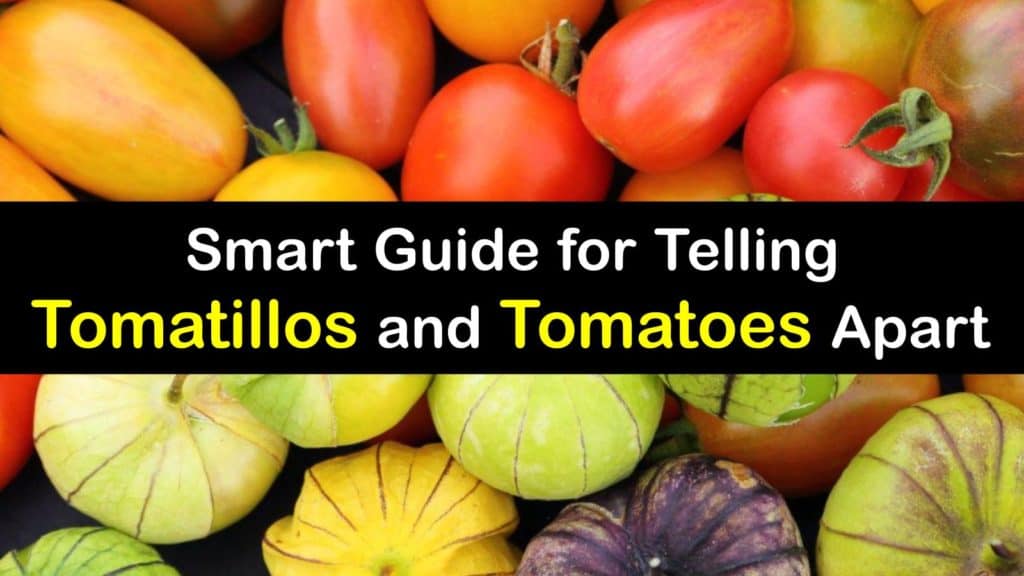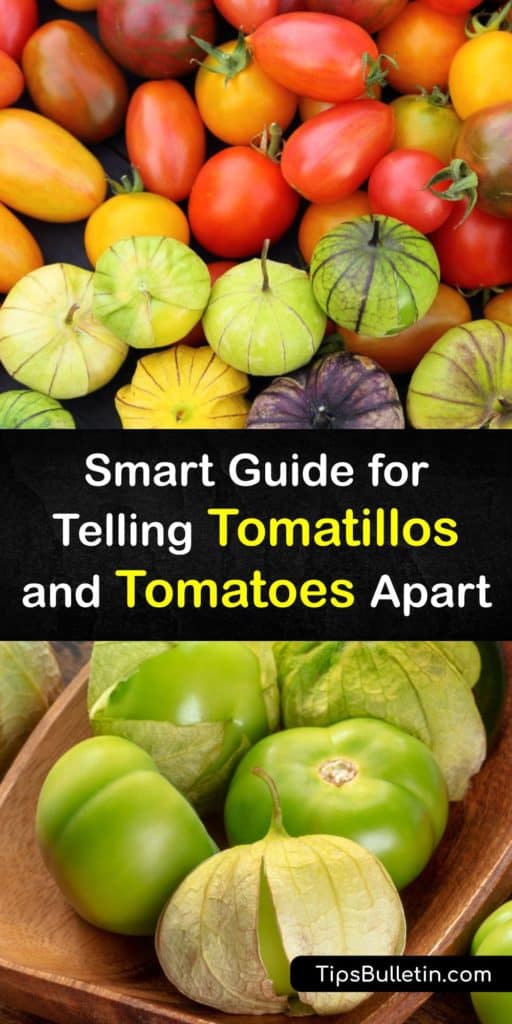Have you ever wondered about those odd-looking veggies at the market that look like small green tomatoes wrapped in a papery husk? These are tomatillos or husk tomatoes, and they are a necessary ingredient in salsa verde and other Mexican dishes. What’s the difference between a tomatillo vs tomato, and are they interchangeable in recipes?
We’ve all seen or grown beefsteak or cherry tomato plants in the garden, but it’s not every day that you see a tomatillo plant. They are both members of the nightshade family, but the tartness of a tomatillo is quite different from a tomato’s sweetness.
All tomatillo fruits are green, while tomatoes range in size and color, from green and yellow to orange and bright red. They are both delicious eaten raw or cooked and popular for use in Mexican cuisine, but that’s where their similarities end.

Differences between Tomatillos and Tomatoes and Their Uses
Tomatillos are relatively small, and the fruit hides beneath a dry husk. The name is misleading since it literally means little tomato. While they are necessary for making green salsa, they are not as common in grocery stores as tomatoes.
We love topping tacos with fresh tomatoes and using tomatillos to make a green sauce for enchiladas, and guacamole is just not the same without adding these fruits. Is a tomatillo the same thing as a tomato, and is there a difference between green tomatoes and tomatillos?
While a tomatillo and tomato are different fruits, they do have some commonalities. Discover their flavor and appearance, nutritional values, and ways to use them in a recipe. Find out whether unripe tomatoes are a suitable substitute for tomatillos in various dishes.
Difference between Green Tomatoes and Tomatillos
Are tomatillos the same as green tomatoes? While they seem similar, these two fruits are not the same. While growing tomatillo plants is somewhat like growing tomatoes, they are each unique plants. Learn the difference between green tomatoes and tomatillos and their growing habits, appearance, and taste.

The tomatillo (Physalis ixocarpa) goes by many names, including husk tomato, ground cherry, jamberry, and Mexican green tomatoes.
Most tomatillo types remain green as they mature, while unripe tomatoes start green and ripen to orange, yellow, red, burgundy, and sometimes green.
A tomatillo fruit is small and round, smaller than the largest Roma tomatoes. Tomatoes (Solanum lycopersicum) grow in a variety of sizes and shapes, from round to oblong.
Tomatillos are a Latin American plant domesticated by the Aztecs in Mexico and related to Cape gooseberries. They resemble small, unripe tomatoes, but their skin is covered with a sticky residue and nestled inside a papery husk that wards off insects.
The inside of a tomatillo is denser than a tomato or tomate, and it is slightly more acidic and less sweet. A tomatillo plant grows 18 to 36 inches tall with an 18 to 24-inch spread, while tomato plants vary depending on the type, ranging from 3 to 12 feet tall.
When are green tomatoes in season? What about tomatillos? These fruits can be available year-round but are more prolific in summer and early fall.
Black spots on tomatoes are just as bad as seeing them on your tomato plants. Address disease and insect issues quickly to save your crops.
Nutritional Values of Tomatillo vs Tomato
We know that fruits and veggies are a good addition to our daily diet, but some have more vitamins than others. Here is how the tomatillo vs tomato varies in nutrition and the health benefits each one provides.
Tomatillos have more calories, fat, and protein than tomatoes, while tomatoes have more lycopene and calcium, even the different types of baby tomatoes. However, both fruits are a great source of nutrients, including potassium, manganese, vitamin C, vitamin A, vitamin K, and folate.
Tomatillos cleanse the body of toxins, improve digestion, and control blood pressure, and tomatoes decrease the chance of heart disease and are good for cancer prevention. Combining them in recipes is a great way to get the benefits of both.
Are Tomatoes a Good Substitute for Tomatillos?
You can usually replace one type of tomato for another while preparing food, but can you use tomatoes as a substitute for tomatillos? Learn which tomatoes are useful substitutions when a recipe calls for a tomatillo and the best dishes to use them interchangeably.
Fresh tomatillos and tomatoes are interchangeable in salsa and guacamole, and they actually complement each other if you use both of them. However, there are times when you don’t have both on hand while preparing a dish. Can you substitute one for the other?
The best substitute for tomatillos is unripe tomatoes with thick skin. To get the same flavor, add a tablespoon of lime juice during preparation.
Grocery stores also carry canned tomatillos if you do not find any fresh ones in the produce section. Other replacement choices are gooseberries, green bell peppers, cherry tomatoes, green and red chilies, and salsa verde.
If you’re looking for tomato substitutes, replace a green tomato with a tomatillo, and use canned tomatoes or bell peppers. While these ingredients do not have the same flavor, they make suitable fillers for recipes.
Using Tomatillos and Tomatoes to Make Guacamole
Guacamole is popular as a dip and sandwich topping, and we combine the flavor of red tomatoes and tomatillos to make a dip with vibrant color and kick. It serves twelve, making it perfect for a gathering of friends and family.
Combine the avocado, tomatillos, Roma tomatoes, red onion, cilantro, and lime juice in a medium bowl and season with the hot pepper sauce, red pepper flakes, salt and pepper, and the desired amount of chopped cilantro. Chill the dip in the fridge for 45 minutes and serve with a side of tortilla chips.
Combining Tomatillos and Tomatoes in a Salsa
Salsa is one of our favorite dipping sauces and an evening of Mexican food is not complete without beginning with salsa and chips as an appetizer. While most recipes call for red tomatoes, combining both tomatoes and tomatillos creates a unique dip.
Husk the tomatillos, wash both fruits, remove the stems, and roast them in the oven for 20 to 25 minutes at 400°F.
Allow them to cool and pour the roasted tomatillos and tomatoes in a blender with the onion, peeled garlic clove, rinsed and destemmed peppers, and cilantro.
Blend them to the desired consistency, and add salt to taste and a squeeze of lime juice. Serve the salsa immediately, or chill it in the refrigerator in an airtight container for a few days.
While a tomatillo and tomato look similar in appearance, minus the husk, they are different fruits. Fresh, red tomatoes are ideal for adding to a salad or slicing on a hamburger, and the mildly tart flavor of tomatillos is perfect for making a spicy green sauce.
However, there are some recipes where the two fruits are interchangeable, and they are both a healthy addition to your diet.

We hope that understanding the differences between a tomatillo vs tomato helps you create delicious Mexican dishes, and we’d love it if you’d share our tomatillo and tomato guide with your family and friend circle on Facebook and Pinterest.